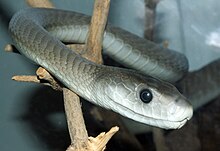Black Mamba
| Black mamba | |
|---|---|
 |
|
| Scientific classification | |
| Kingdom: | Animalia |
| Phylum: | Chordata |
| Class: | Reptilia |
| Order: | Squamata |
| Suborder: | Serpentes |
| Family: | Elapidae |
| Subfamily: | Elapinae |
| Genus: | Dendroaspis |
| Species: | D. polylepis |
| Binomial name | |
|
Dendroaspis polylepis Günther, 1864 In red, range of D. polylepis |
|
| Synonyms | |
|
|
In red, range of D. polylepis
In brown, D. polylepis may or may not occur here
The black mamba (Dendroaspis polylepis) is a venomous snake endemic to parts of sub-Saharan Africa. Specimens vary in color from grey to dark brown, but not black. Juvenile black mambas tend to be lighter in color than adults and darken with age. It is the longest species of venomous snake indigenous to the African continent; mature specimens generally exceed 2 meters (6.6 ft) and commonly attain 3 meters (9.8 ft). Specimens of 4.3 to 4.5 meters (14.1 to 14.8 ft) have been reported.
Although most mamba species are tree-dwelling snakes, the black mamba is not generally arboreal, preferring lairs in terrestrial habitats in a range of terrains. These include savannah, woodlands, rocky slopes and in some regions dense forest. It is diurnal and chiefly an ambush predator, known to prey on hyrax, bushbabies and other small mammals as well as birds. It is also a pursuit predator; in this it resembles some other long, speedy, highly-venomous species with well-developed vision. Over suitable surfaces it is possibly the speediest species of snake, capable of at least 11 km/h (6.8 mph) over short distances. Adult mambas have few natural predators.
In a threat display, the mamba usually opens its inky black mouth, spreads its narrow neck-flap and sometimes hisses. It is capable of striking at considerable range and occasionally may deliver a series of bites in rapid succession. Its venom is primarily composed of potent neurotoxins which may cause fast onset of symptoms. Despite its reputation for being formidable and highly aggressive, like most snakes, it usually attempts to flee from humans unless threatened or cornered. Not being proximal to humans, bites from the black mamba are not frequent.
The black mamba, Dendroaspis polylepis, is an elapid within the genus Dendroaspis. Although it had been known to missionaries and residents, prior to 1860, by the name "mamba". Which was already established in the vernacular and taken from the Zulu word "imamba". The first formal description was made by Albert Günther in 1864. In 1873, Wilhelm Peters described two subspecies: the nominotypical D.polylepis polylepis and also D.polylepis antinorii. However, these are no longer held to be distinct. In 1896, Boulenger combined the species (Dendroaspis polylepis) as a whole with the eastern green mamba (Dendroaspis angusticeps), a lumping diagnosis that remained in force until 1946, when FitzSimons split them again into separate species.
...
Wikipedia



